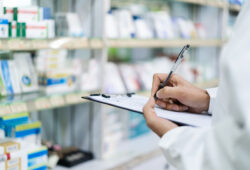HealthTrust IHP
How can plan sponsors protect themselves?
Over the past 10 years, Pharmacy Benefit Managers (PBMs) have implemented an ever-increasing list of formulary exclusions, citing the need to drive down cost from low-value or questionably effective medications. But these exclusions have evolved, as many commonly used drugs are now subject to exclusions due to head-head competition.
Within the world of prescription drugs, some drug categories are crowded. Physicians may have a dozen choices for their patients for conditions like heart disease or high cholesterol. In other cases, a small group of high-cost specialty drugs with similar indications are competing head-head, just note the ads on TV and other media. This has set up the need for better formulary management and programs to help manage these high-cost conditions.
Years ago, PBMs began excluding high-cost, low-value drugs like Duexis (Motrin + Pepcid) which had a list price of $2,400 per month, despite having OTC options less than $20 per month. Exclusions have evolved today, where PBMs may draw a line through an entire category and prefer one company’s products, excluding all others. We see this today with insulin, i.e. Lilly vs. Novo for insulin. This may help push up rebates, but it does not lower costs to the consumer.
With ever increasing rebates, plan sponsors have never been at higher risk. Contract ambiguity around rebates is wide spread and protects only the PBM. Formulary exclusions are not going away which is why trusted partners are critical to fight back. It has become essential to continuously monitor your formulary and apply a high level of rigor to drugs deemed unnecessary.
Challenges
PBMs look to protect their profits like any business. There’s a difference between a fair, reasonable profit and unchecked, perverse incentives. Firm guarantees, detailed contract terms to protect from manipulation and aggressive clinical programs are a great start. And when it comes to formulary changes, are they in the best interests of your plan participants/patients?
Consider the following scenario:
- The PBM decides to place two Specialty Drugs in preferred formulary status for a specific disease, excluding two other options, (all 4 options are competitive).
- The PBM applies a prior authorization and handles all approvals for these Specialty Drugs (often with additional fees).
- They also mandate the dispensing of these Specialty Drugs through their in-house Specialty Pharmacy, at a cost of thousands of dollars a month.
- At the end of each quarter, the PBM submits claims experience for these Specialty Drugs to the manufacturers for a rebate, plus any additional educational or administrative fees.
The obvious problem here is that the PBM drives all aspects of the patient experience, deciding on what’s clinically appropriate, all while reaping the benefits from dispensing and rebate activities. There is no accountability.
However, there are several ways a plan can protect themselves:
- Check for prior auth approval rates – does the PBM publish approvals/denials? Are they “rubber-stamping” approvals at a 90%+ rate? Consider the perverse incentives of the supply chain.
- Does the contract demand 100% rebates back to the plan, including all fees?
- Best in class PBM programs provide reporting to track adherence and other outcomes.
- Do they have programs to watch stockpiling, like a quantity over time edit?
- Are they communicating with providers who most frequently prescribe the highest cost drugs among their peers?
A tighter formulary will likely increase rebates – is the PBM sharing this increase?
- Will the PBM increase the guaranteed rebate payout?
- Will the PBM provide communication support and outreach to offer alternatives? Are patients given time to change (i.e. 90 days’ notice).
What if a PBM decides to exclude products that were not preferred in the first place (Tier 3, non-preferred brand that’s now “fully excluded”).
- Is this in the best interest of the client and members? Will it create a higher rebate with other preferred products, while reducing cost but adding disruption?
- Or will it line the pockets of the PBM?
Check for contract caveats on “rebate eligible” drugs. Some PBM contracts have an incredibly broad definition of rebate payout exclusions. For example: “liquids, inhalers, devices” may be ineligible for a rebate payout, despite driving significant rebates. Are the formulary exclusions impacting categories “excluded” from rebate payouts?
Impact & opportunities
With new expensive products hitting the market (e.g., Hemgenix for hemophilia) and increased use and indications for other products (e.g., GLP-1s used for weight loss and/or diabetes), this will put increased pressure on costs and trend for the coming years. Somewhat offsetting that will be the emerging biosimilars for Specialty Drugs (e.g., for Humira).
All of these threats and factors provide real opportunities for PBMs to develop more meaningful clinical programs. The advancement of gene therapies opens an avenue for greater collaboration between the PBM and care providers. Individualized patient care through pharmacogenomic programs emphasize innovative strategies to ensure a more accurate assessment and drug selection criteria for patients.
PBMs can help plan sponsors and their members by improving site of care steerage in certain high-cost categories such as gene therapy and Specialty conditions. Drug therapies administered in office by physicians vs. hospital visits can be far less expensive and more convenient. And there’s more work to do between PBMs and drug manufacturers to negotiate contracts that tie drug rebates to patient outcome metrics. The better the outcome, the higher the rebate.
Unlike traditional PBMs where they hold all the power, a better option is a consortium where the members have control over formulary decisions and vote on them, rather than simply being at the mercy of the PBM. It takes extensive work to understand the financial and patient impact, plus other implications of the change and decide the course based on the data.
What can plan sponsors do to prepare?
In order to prepare for the challenges and opportunities associated with increasing formulary exclusions, best practices among plan sponsors include having the PBM communicate with their members and physicians about changes to the formulary.
Additionally, plan sponsors should ensure that the exclusions are driven towards the lowest net cost and make clinical sense, rather than pushing utilization towards products that have bigger rebates but could cost more. It is important for plan sponsors to challenge their PBMs if they disagree with an exclusion, can’t show value from the updates or may negatively impact patient outcomes.
By working closely with their PBMs and other healthcare providers, plan sponsors can help to ensure their formularies are designed to provide the most cost-effective and clinically appropriate treatments to their members. Ultimately, high performing organizations take control of the formulary decisions and don’t simply let the PBM dictate the answer.
To learn how HealthTrust addresses these issues, set up a quick call with Stephen.Magosin@HealthTrustpg.com.
We can share how we work for our clients by leveraging our in-house clinical team to develop a higher level of oversight and precision. Our Prior Auth approval rates are 15-20% points lower than the industry average. Plus, we monitor physician trends, providing outreach to high volume prescribers falling outside the norms.
If you’re interested in learning more in navigating your PBM program, download the in-depth guide
Top 5 Things to Know to Negotiate a PBM Contract here





